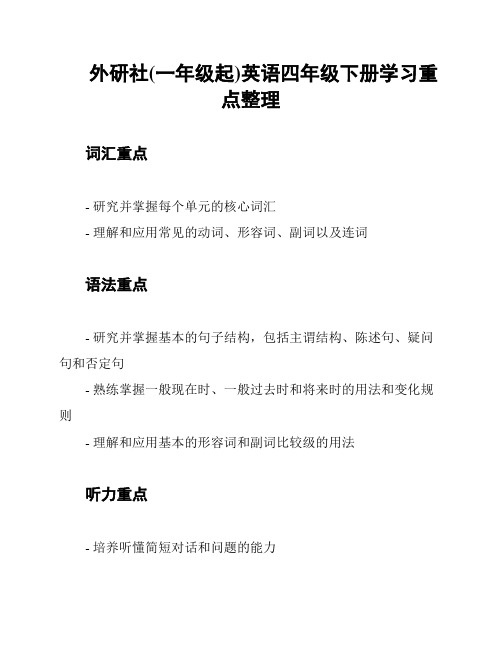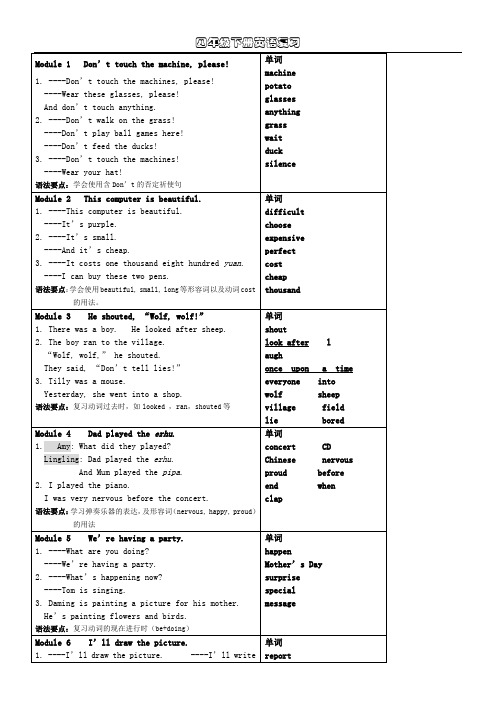外研社小学英语一年级起点四年级下知识点
- 格式:doc
- 大小:21.50 KB
- 文档页数:5



Contents四年级下Module 1 (1)四年级下Module 2 (3)四年级下Module 3 (7)四年级下Module 4 (10)四年级下Module 5 (13)四年级下Module 6 (17)四年级下Module 7 (22)四年级下Module 8 (27)四年级下Module 9 (31)四年级下Module10 (35)四年级下Module 1重点:Do 型祈使句让别人不要做某事的句型表达“某人可以……"的句型难点:让别人不要做某事的句型短语make crisps 制作炸薯片wash the potatoes 清洗马铃薯cut the potatoes 切马铃薯touch the machines 触摸机器a bag of crisps 一袋炸薯片feed the fish 喂鱼walk on the grass 践踏草坪play ball games 玩球类游戏write on the books 在书上写(字)惯用表达式Sorry.对不起。
Look! 看核心句型1.Don't touch the machines, please!请不要触摸这些机器解读这是劝告他人不要做某事的句子。
2.You can each have a bag of crisps.你们每个人都可以拥有一袋炸薯片。
解读这是表达“某人可以……"的句子。
了解句型1.The baby is sleeping.这个婴儿正在睡觉。
解读这是表达某人正在做某事的句子。
2.Sing for the baby! 为婴儿唱歌!解读这是建议他人做某事的 Do 型肯定祈使句。
Unit 1 知识点精析1.Don't touch the machines, please!请不要触摸这些机器。
这是劝告他人不要做某事的句子。
【句型结构】Don't+动词(短语)原形(+其他)【噩点解析】这是一个 Do 型祈使句的否定形式。

外研社(一年级起)英语四年级下册学习重
点整理
词汇重点
- 研究并掌握每个单元的核心词汇
- 理解和应用常见的动词、形容词、副词以及连词
语法重点
- 研究并掌握基本的句子结构,包括主谓结构、陈述句、疑问句和否定句
- 熟练掌握一般现在时、一般过去时和将来时的用法和变化规则
- 理解和应用基本的形容词和副词比较级的用法
听力重点
- 培养听懂简短对话和问题的能力
- 提高听懂日常生活中关于时间、地点、人物和活动的问题的能力
- 研究听懂简短故事并提取关键信息的能力
口语重点
- 练运用学过的词汇和句型进行简单的日常会话
- 学会表达自己的观点、感受和喜好
- 提高与他人交流和合作的能力
阅读重点
- 通过阅读短文和故事,培养理解和抽取关键信息的能力
- 学会根据文中提供的信息回答问题
- 提高阅读时的语音和语调的表达能力
写作重点
- 练书写短文和简单的句子,描述自己的家庭、朋友和学校生活
- 学会运用所学词汇和语法结构进行基本的写作对话和情景
以上是外研社(一年级起)英语四年级下册的学习重点整理。
通过重点的学习和实践,学生们将能够提高听说读写的能力,更好地运用英语进行交流和表达。


外研社一年级起点小学四年级英语下册知识点Module 1 这机器出了什么故障machine英[mi:n] / 美[min] n.机器What's the trouble with the machine?这机器出了什么故障?welcome英[?welk?m] /美[?w?lk?m] vt.欢迎Welcome to las Vegas.欢迎来到拉斯维加斯。
*crisp英[kr?sp] / 美[kr?sp] n.炸薯片A packet of crisps.一包炸薯片。
sir英[s?:(r)] / [s?] n.先生Good afternoon to you, sir.下午好,先生。
potato英[p??te?t??] /美[p??te?to?] n.马铃薯,土豆I want some meat and potatoes.我想要一些肉和土豆。
dangerous英[?de?nd??r?s] /美[?dend??r?s] adj.危险的Don't run down the stairs. It's dangerous!不要跑下楼梯,太危险了!put英英[p?t] / 美[p?t]vt.放,安放,放置Who put my little cat there?是谁把我的小猫咪放那儿的?wait英[we?t]/ 美[wet] vt.& vi.等;等待The spider must wait for prey to be ensnared on its web.蜘蛛必须等待猎物被它的蛛网困住。
each英[i:t?] /美[it?] pron.各自;每个Each cell of our bodies contains 46 chromosomes.我们人体的每个细胞都包含46个染色体。
Module 2 他们全天供应早餐,而且价钱公道cheap英[t?i:p] / 美[t?ip] adj.便宜的They served breakfast all day and sold it cheap.他们全天供应早餐,而且价钱公道。
Module 1【关键知识点】✧“要别人做某事或不做某事”用祈使句,句中动词要用原形。
➢表示禁止的:Don’t…please!➢表示肯定的:Wear… please!祈使句:动词原形开头,省略主语(变否定直接在动词前面加Don’t)Eg:Open the door,变否定为Don’t open the door【重要句型】➢Don’t sing here! 不要在这儿唱歌。
➢Don’t write here! 不要在这儿写字。
➢Don’t talk here! 不要在这儿说话。
➢Wear the glasses! 戴上眼镜。
➢Wear the hat! 戴上帽子。
➢Stop! 停下来。
➢Don’t feed the ducks! 不要喂鸭子。
➢Don’t walk on the grass! 不要踩草地。
➢Don’t touch the machines! 不要碰这些机器。
➢Don’t write on the books! 不要在书上写字。
➢Silence! 安静。
➢Wash your hands! 洗手。
【重要词汇】1.factory 的复数是factories 工厂2.children孩子们,单数是child3.these这些,单数是this4.those那些,单数是that5.crisp炸薯片,复数是crisps6.do的三人称单数是does 做7.wash的三人称单数是washes 洗8.put的三人称单数是puts 放9.potato的复数是potatoes练习:一、单项选择1.Don’t______ on the grass A. walks B.walk C.walking2.Please______the door A.open B.opens C.opening二、填上适当的词1.This machine____(make) crisps2.Don’t______(walk) on the grass3.You can have a bag of____(crisps) now4.What____(do) this factory do?5.These_____(machine)cut potatoes6.It_____(wash) the tomatoes7.Don’t______(touches) the machines8.This machine____(put)the crisps in the bags9.The baby is____(sleep) now10.They are____(potato)Module 2【关键知识点】✧重点学习用形容词来形容物品,主要句型是:➢This …is….➢It’s…【重要句型】➢This computer is beautiful. It’s purple. 这台电脑很漂亮。
四年级下册Module 1知识汇总一、词汇machine 机器welcome 欢迎crisp 炸薯片sir 先生potato 马铃薯,土豆dangerous 危险的put 放,安放,放置wait 等;等待each 各自,每个二、句子1. These machines make crisps. 这些机器做薯条。
2. —What does this machine do, sir? 这个机器是做什么的,先生?—It washes the potatoes. 它是洗土豆的。
3. Don’t touch the machines, please! 请不要触摸这些机器!4. They are dangerous. 它们很危险。
5. You can each have a bag of crisps. 你们每人可以得到一包薯条。
6. Don’t feed the baby. 不要给那个婴儿喂食。
7. Play with the baby! 和婴儿一起玩。
8. Don’t write on the books. 不要在书上写字。
9. Don’t walk on the grass! 不要踩草坪。
10. Be quiet, please! 请安静!三、句型结构1. Don’t + 动词原形+ 其他. 用于提醒某人不要做某事。
eg: Don’t make noise in class. 不能在课堂上喧闹。
2. 动词原形+ 其他. 祈使句,表示让(请)某人做某事。
eg: Hold on, please. 请稍等。
Be careful! 小心!四年级下册Module 2 知识汇总一、词汇cheap 便宜的expensive 昂贵的send 发送;寄email 电子邮件cost 花费;价钱为hundred 一百二、句子1. I’ve got a new hat. 我有一顶新帽子。
2. —What colour is it? 它是什么颜色的?—It’s pink. 它是粉色的。
外研版小学英语一起四年级下册知识点汇总1. 单词和词组- 本册单元 1 中的重要单词和词组有:apple、banana、watermelon、orange、grape、bread、milk、tea、hamburger、hot dog、I like 、me too、not bad.- 本册单元 2 中的重要单词和词组有:tomato、potato、carrot、cabbage、pear、strawberry、chicken、beef、fish、egg、noodle、rice、potato chips、salad、I don’t like、How about 、I’m sorry、one more time.- ...2. 语法- 本册单元1 中的语法重点是介词in、on、under 和量词some、a glass of.- 本册单元 2 中的语法重点是物主代词 my、your、his、her 和谓语动词有关的疑问句。
3. 句型- 本册单元 1 中的重点句型有:I like apples.、I like bananas.、I like watermelons.、Do you like grapes?、Yes, I do.、No, I don’t.- 本册单元 2 中的重点句型有:I like tomatoes.、I like carrots.、I like potatoes.、Do you like cabbage?、Yes, I do.、No, I don’t.4. 听力和口语- 本册单元 1 中的听力和口语部分主要包括日常食物的表达和对喜好的表达。
- 本册单元 2 中的听力和口语部分主要包括日常蔬菜的表达和对喜好的询问和回答。
5. 阅读和写作- 本册单元 1 中的阅读部分包括简单的对话和填空题,写作部分主要是书写单词和句子。
- 本册单元 2 中的阅读部分包括简单的短文和选择题,写作部分主要是书写句子和回答问题。
英语(四年级下)主要知识点整理
(例句都是课本中原句)
1.祈使句:表示请求、命令、建议等的句子。
祈使句不需要主语,谓语动词用原形,句子末尾一般用感叹号。
eg: (1) Don’t walk on the grass! (否定祈使句)
(2)Let’s make a newspaper! (肯定祈使句)
2.一般现在时:经常发生的动作或状态(常与always, usually, often, sometimes, seldom, never, every day/week/year, on Sundays ...连用)
(1) be动词的一般现在时:(比较简单)
I am, We/You/They are, He/She/It is,There is+单数名词或不可数名词, There are + 复数名词
eg: It’s not beautiful, but it’s helpful.
(2) 行为动词的一般现在时:(单数第三人称的变化是重点、易错点; 助动词用do, don’t, does, doesn’t)
eg: (1)This machine cuts the potatoes.
(2) Does he live in New York?
(3) Fish live in the river and birds live in the tree. (***注意fish单数和
复数写法一样,这里fish前面没有a, 所以是复数形式,后面接谓语动词要用原形。
另外,Sheep和deer单复数也是一样的形式)
3.一般过去时:表示过去发生的动作或状态(常与...ago, yesterday, the day before yesterday, last week/year/month, once upon a time, one day, the next day, in 2016...连用)
(1)be动词的一般过去时:
I/He/She/It was, We/You/They were, There was+单数名词或不可数名词, There were + 复数名词
eg:Once upon a time, there was a boy. (讲故事常用说法)
(2)行为动词的一般过去时:(助动词用did, didn’t)
①一般动词变化:
构成法:1. 动词原形+ed. 如:look--looked
2.以e结尾的词+d. 如:live--lived
3.以辅音字母+y结尾的词,改y为i, 再加ed.
如:study--studied, cry--cried.
4.以重读闭音节或r音节结尾,末尾只有一个辅音字母的词,
双写这个辅音字母,再加ed. 如: clap--clapped, stop--stopped,
prefer--preferred
②不规则动词变化:如had, said, put, saw, got, ran, learnt(英式写法),
bought, came, took, went等
eg1: The animals had a concert last week.
eg2: The next day, the boy ran to the village again.
eg3: What did he play yesterday?
eg4: When did you get up last Sunday? I got up at 8 o’clock.
4.一般将来时:表示还没有发生但将要发生的事情或动作(常与tomorrow, the day after tomorrow, next year/month/week, soon, in the future, in ... minutes/hours/days...连用)
(1)Be going to+ 动词原形:多表示即将发生,最近打算、计划、安排好要做的事情,主观性较强(区分人称,be动词变化am, is, are) eg: She’s going to visit Australia.
(2)Will+动词原形:多表示即将发生的动作或状态,不受主观因素影响的单纯的将来,客观性较强(不区分人称,都用will)
(***目前小学阶段对这两种形式区分并不明显,可以互换使用) eg: We will go to the zoo on Sunday.
5.现在进行时:表示正在进行或发生的动作(常与now, at present, at this moment连用)
Be动词+动词的现在分词(***区分人称,注意动词的现在分词构成的特殊情况)
动词的现在分词构成法:
(1)一般规则:动词+ing, 如: work--working.
(2) 以e结尾的动词去掉e加ing. 如: live--living, have--having.
(3) 以重读闭音节或r音节结尾,末尾只有一个辅音字母的词,双写这个辅音字母,再加ing. 如: swim--swimming, clap--clapping, refer--referring.
(4) 以ie结尾的重读开音节的词,改ie为y, 再加ing. 如: die--dying. eg: (1) What’s happening now?
(2) Daming is making a card for his father.
(3)We are having a party.
6.购物相关话题:
(1)I want to buy a pen.
(2)It’s expensive/cheap.
(3)It costs one hundred and eighteen yuan.
(4)Who wants to buy it?
7.音乐演奏相关话题:(***演奏乐器前要加定冠词the )
(1)I played the piano yesterday.
(2)You’re playing the violin for your father.
(3)My mum and dad played in the concert.
(4)In the end, everyone clapped.
(***注意玩球类运动不能加定冠词the, eg:I played football yesterday. ) 8.时间相关话题:
(1)What’s the time now?
(2)What time is it now?
(3)It’s 2o’clock.
(4)Is it breakfast/lunch/dinner time now?
(5)The Chinese cartoon Shaolin Kids is on TV at 8 o’clock.
9.方向相关话题:
(1)Where is the library?
(2)It’s in the north/south/west/east of China.
(3)I went to the north/south/west/east.
(4)Beijing is the capital of China.
10.原因相关话题:
(1)Why do fish live in the river?
(2)Because cats can’t live in the water.。